Opioid Analgesics Important Notes
1. Opioid Analgesics Classification
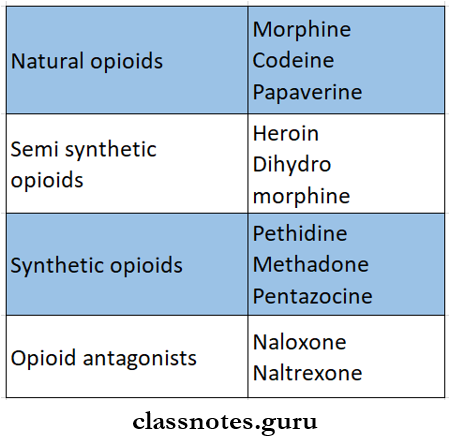
2. Opioid Analgesics Morphine
- It is obtained from papaver somniferum
- Actions
- Relieves severe pain like visceral pain
- Produces sleep
- Produces euphoria
- Produces miosis
- Respiratory depression
- Causes vomiting by stimulating the chemoreceptor trigger zone (CTZ)
Read And Learn More: Pharmacology Question and Answers
- Opioid Analgesics Morphine Adverse effects
- Euphoria, dysphoria, and mental clouding
- Respiratory depression
- Tolerance and drug dependence
- Acute morphine poisoning – is characterized by
- Respiratory depression
- Pinpoint pupils
- Hypotension
- Shock
- Coma
- Opioid Analgesics Morphine Uses
- Analgesics
- For producing sleep and sedation
- As pre-anesthetic medication
- As antitussive
- In the treatment of acute left ventricular failure.
- Opioid Analgesics Morphine Contraindications
- Asthma
- Head injuries
- Undiagnosed acute abdominal pain
- infants and elders
- Hypothyroidism
- COPD
- Unstable personalities
- Opioid Analgesics Morphine Withdrawal symptoms
- Lacrimation
- Yawning
- Anxiety
- Abdominal colic
- Diarrhea
- Mydriasis
- Palpitation, rise in BP
- Weight loss
3. Opioid Analgesics Fentanyl
- It is short acting IV opioid analgesic
- Used for general anesthesia and conscious sedation
4. Opioid Analgesics Remifentanil
- Indicated as an opioid analgesic adjunct for induction and maintenance of general anesthesia
- It should not be used alone
- Should not be used for epidural or intrathecal administration as glycine in it may cause neurotoxicity
Opioid analgesics notes
Opioid Analgesics Long Essays
Question 1. Classify the narcotic analgesic group of drugs and write about morphine.
Answer:
Narcotic/Opioid Analgesic:
- Opioid analgesics are analgesics that are either derived from opium or resemble opium in action.
Opioid Analgesic Classification:
1. Natural opium alkaloids – morphine, codeine.
2. Semi-synthetic opiates – diacetylmorphine, pholcodine.
3. Synthetic opioids – pethidine, fentanyl, methadone.
Morphine: Morphine is a natural opioid and the principal alkaloid in opium.
Morphine Actions:
1. Morphine CNS actions:
- Morphine is potent analgesic.
- Produces euphoria, sedation, and hypnosis.
- Morphine has a calming effect, a feeling of detachment.
- Depresses respiratory center.
- Depresses cough center.
- Depresses the temperature regulating center and causes hypothermia.
- Depresses vasomotor centre and reduces BP.
- Morphine stimulates.
- CTZ – induces vomiting.
- Edinger Westphal nucleus – produces miosis.
- Vagal center – causes bradycardia.
- Cortical areas and hippocampal cells.
2. Morphine Neuro-endocrine actions.
- Morphine weakens hypothalamic influence on the pituitary.
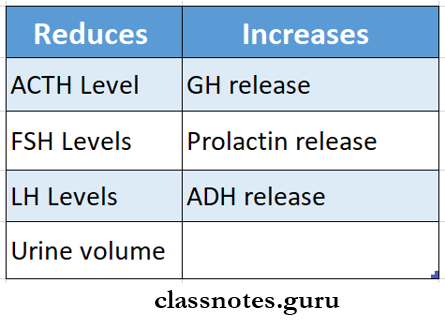
3. Morphine CVS action.
- Morphine causes vasodilatation due to.
- Histamine release.
- Depression of vasomotor center.
- Decreases tone of blood vessels.
4. Morphine GIT action.
- Morphine causes constipation.
- Decreases propulsive movements.
- Decreases GIT secretions.
5. Morphine Smooth muscles.
- The biliary tract causes spasms of the sphincter of Oddi.
- Urinary bladder increases the tone of the detrusor and sphincter.
- Bronchi-causes bronchoconstriction.
Morphine Uses:
1. As analgesic.
- Morphine is used in traumatic, visceral, ischaemic, postoperative, burn, and cancer pain.
- Adequate use of morphine is indicated in an emergency.
2. As pre-anesthetic medication.
- Used in selected patients.
3. Balanced anesthesia and surgical analgesia.
- An important component of anesthetic techniques.
4. Relief of anxiety and apprehension.
- Used in myocardial infarction.
5. Acute left ventricular failure.
- Used to alleviate dyspnea.
6. Diarrhea.
- Used for symptomatic treatment
Morphine Adverse Effects:
- Nausea, vomiting, constipation, urinary retention.
- Dizziness, mental clouding, dysphoria.
- Respiratory depression, hypotension.
- Apnea – when administered to a pregnant woman in labor.
- Allergic reactions – skin rashes, pruritis, and wheal at the site of injection.
- Tolerance and dependence develop.
- Withdrawal symptoms in newborns – irritability, excessive crying, tremors diarrhea, sneezing, yawning, vomiting, and fever.
Opioid analgesics pharmacology
Question 2. Discuss the uses and toxic effects of morphine. Name morphine antagonists available.
Answer:
Morphine Antagonists:
1. Morphine Antagonists Naloxone.
- It is the competitive antagonist.
- It Is devoid of any agonist actions.
- Injected Intravensouly It antagonizes all actions of morphine.
- Analgesia.
- Normalizes and stimulates respiration.
2. Morphine Antagonists Naltrexone.
- It Is orally active.
- More potent
- Have a longer duration of act Ion
- It Is used for ‘opioid blockade
- It reduces alcoholic cravings.
3. Morphine Antagonists Nalmefene.
- Effective orally.
- Used In opioid overdosage.
Question 3. Classify analgesics. Discuss Indications. Contraindications for the use of morphine giving reason.
Answer:
Analgesics:
- Analgesics is a drug that relieves pain without loss of consciousness.
Analgesics Classification:
They are classified into two classes.
1. Opioid analgesics:
- Natural opioid.
- Morphine, codeine, noscapine.
- Semisynthetic derivatives.
- Heroin, oxymorphone, pholcodine.
- Synthetic opioids.
- Pethidine, fentanyl, diphenoxylate, loperamide, dextropropoxyphene, methadone, and tramadol.
2. Non-opioid Analgesics:
- Non-selective Cox inhibitor.
- Salicylates – aspirin.
- Proprionic acid derivative – Ibuprofen.
- Anthranilic acid derivative – mefenamic acid
- Aryl-acetic acid derivatives – diclofenac, ace- clofenac.
- Oxicam derivatives – piroxicam, tenoxicam.
- Pyrrolo – pyrrole derivative – ketorolac.
- Indole derivative – indomethacin.
- Pyrazolone derivative – phenylbutazone.
- Preferential COX-2 inhibitors.
- Nemisulide, meloxicam, nabumetone.
- Selective COX-2 inhibitors.
- Celecoxib, etoricoxib, parecoxib.
- Analgesic – antipyretic.
- Para-amino phenol derivative – paracetamol.
- Pyrazolone derivative – metamizol.
- Benzoxazocine derivative – nefopam.
Morphine: Morphine is a natural opioid and the principal alkaloid in opium.
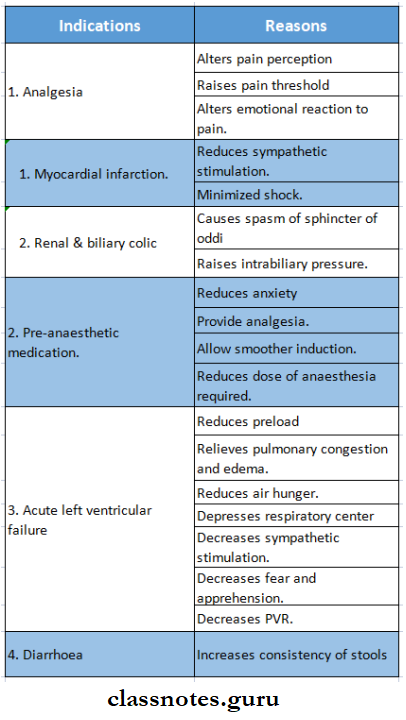
Opioid analgesics classification
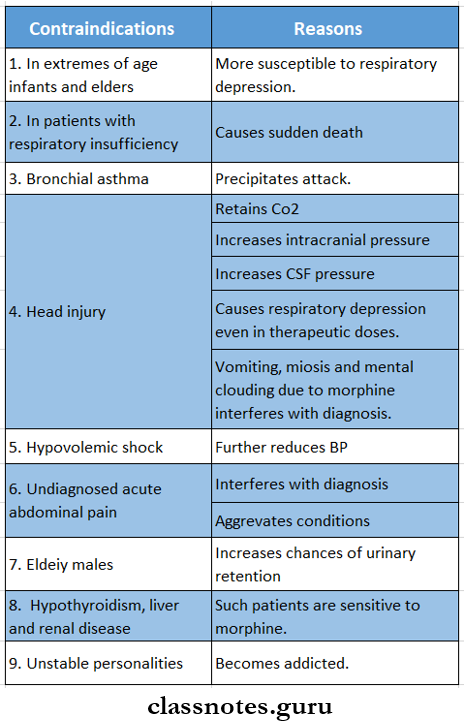
Opioid Analgesics Short Essays
Question 1. Pentazocine.
Answer:
Pentazocine is the first agonist-antagonists to be used as analgesic.
Pentazocine Properties:
- Has weak p antagonist action and more k agonist action.
- Has less addiction liability.
- 20 mg pentazocine is effective to 10 mg morphine. Analgesia is caused primarily spinal.
- It increases heart rate and BP and thereby increases cardiac work.
Dose and route of administration:
- 50 -100 mg – orally.
- 30 – 60 mg – IM
Pentazocine Uses:
- Used in postoperative and chronic pain – bums trauma, fracture, cancer.
Pentazocine Adverse effects:
- Sedation, dizziness.
- Sweating, dysphoria.
- Nausea, nightmares, hallucinations.
- Tolerance and dependence develop.
- Pain and sterile abscess – at the site of injection.
Opioid analgesics uses and side effects
Question 2. Dextropropoxyphene.
Answer:
Dextropropoxyphene is a congener of methadone.
- It binds to opioid receptors and produces effects similar to morphine.
- It has poor antitussive action.
- Its metabolite is cardiotoxic.
Dextropropoxyphene Uses:
- Use in mild to moderate pain.
- Used in combination with aspirin – dextropropoxyphene 32 mg + aspirin 600 mg.
Dextropropoxyphene Adverse effects:
- Has abuse potential.
- High doses cause rapid-onset respiratory depression, delirium, and convulsions.
Question 3. Compare morphine and pethidine.
Answer:
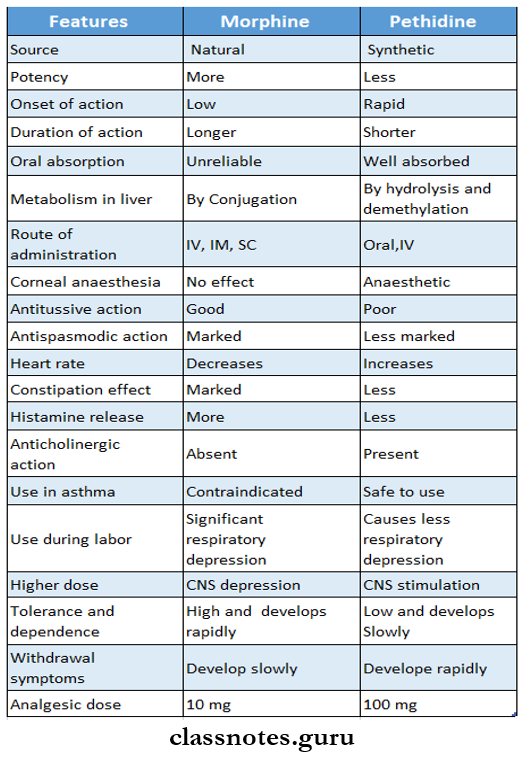
Question 3. Tramadol.
Answer:
- It is a centrally-acting analgesic
- Tramadol Mechanism of Action
- Weak opioid agonist
- Inhibits reuptake of noradrenaline and serotonin → activates mono-aminergic spinal inhibition of pain
- Tramadol Pharmacokinetics
- Good oral bioavailability
- Plasma half-life – 3-5 hours
- The effect lasts for 4-6 hours
- Tramadol Uses
- Acute pain – diagnostic procedures, dental pain
- Chronic pain – including cancer pain
- Tramadol Adverse reactions
- Mild respiratory depression
- Dryness of mouth, sweating
- Dizziness, sedation
- Drug dependence
Opioid analgesics short notes
Opioid Analgesics Short Answers
Question 1. Actions of morphine.
Answer:
1. CNS actions.
- Potent analgesic.
- Produces euphoria sedation, and hypnosis.
2. Respiration.
- Depresses respiratory center.
3. Cough center – depression
4. CVS action
- Reduces BP
- Causes vasodilatation.
5. Nausea and emesis.
- Directly stimulates CTZ.
6. Pupils – produce miosis.
7. GIT actions.
- Decreases propulsive movements.
- Decreases GIT secretions.
8. Neuroendocrine action.
- Weakens hypothalamic influence on the pituitary.
Question 2. Uses of morphine.
Answer:
Morphine is used as
- Analgesic
- Pre-anesthetic medication.
- To relieve anxiety and apprehension.
- Balanced anesthesia and surgical analgesia.
- Acute left ventricular failure.
- Diarrhea.
Question 3. Contraindications of morphine.
Answer:
- In extreme ages.
- In patients with respiratory insufficiency.
- Bronchial asthma.
- Head injury.
- Hypovolemic shock.
- Undiagnosed acute abdominal pain.
- Elderly males.
- Hypothyroidism, liver, and renal diseases.
- Unstable personalities.
Question 4. Codeine.
Answer:
Codeine is methyl-morphine.
- It is a naturally occurring opium alkaloid.
- It depresses the cough center in sub-analgesic doses.
- It is effective orally and well absorbed.
- It has a very low affinity for opioid analgesics.
- Single oral dose acts for 4 – 6 hours.
- It is given at bedtime.
Codeine Uses:
- Used as antitussive.
- Used in combination with paracetamol for analgesia – codeine 30 mg + paracetamol 500 mg
Codeine Adverse effects:
- Constipation.
- Less addictive.
Opioid analgesics drugs list
Question 5. Morphine poisoning.
Answer:
Acute morphine poisoning may be accidental, suicidal, or homicidal.
- In non-tolerant adults; 50 mg of morphine IM produces it.
Morphine poisoning Manifestations:
- Respiratory depression with shallow breathing.
- Stupor or coma.
- Flaccidity.
- Cyanosis.
- Pinpoint pupil.
- Fall in BP, shock.
- Hypothermia.
- Death due to respiratory failure.
Morphine poisoning Treatment:
- Maintenance of BP. By IV fluids.
- Positive pressure respiration.
- Gastric lavage with potassium permanganate.
- Naloxone – 0.4 – 0.8 mg IV repeated every 10 -15 min.
Natural and synthetic opioids
Question 6. Four adverse effects of fentanyl.
Answer:
- Nausea
- Vomiting
- Respiratory depression
- Muscle rigidity
Viva Voce
- Codeine is used for the treatment of cough
- The antidote for morphine poisoning is naloxone
- Opioids are also called narcotic analgesics
- Naloxone is a competitive antagonist on all types of opioids receptors
- Opioids receptors are mu, kappa, and delta
